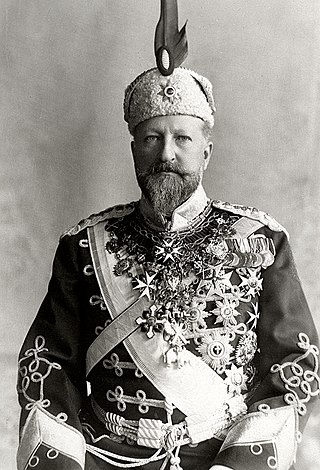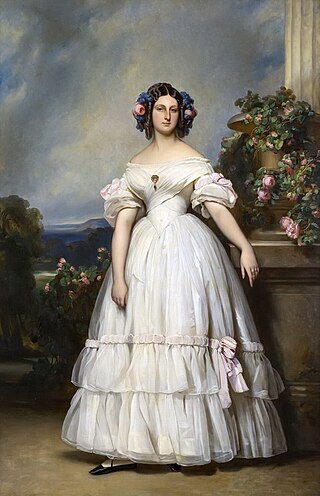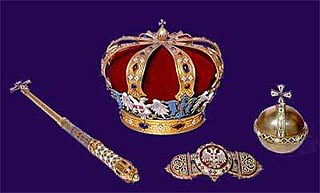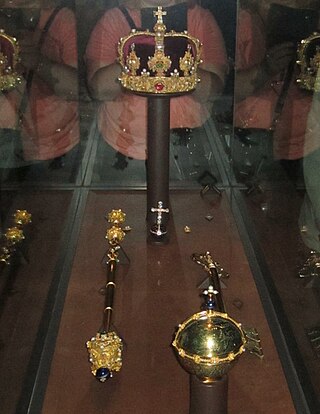
Ferdinand, nicknamed Întregitorul, was King of Romania from 1914 until his death in 1927. Ferdinand was the second son of Leopold, Prince of Hohenzollern and Infanta Antónia of Portugal, daughter of Ferdinand II of Portugal and Maria II of Portugal. His family was part of the Catholic branch of the Prussian royal family Hohenzollern.

Boris III, originally Boris Klemens Robert Maria Pius Ludwig Stanislaus Xaver, was the Tsar of the Kingdom of Bulgaria from 1918 until his death in 1943.

Ferdinand , born Ferdinand Maximilian Karl Leopold Maria of Saxe-Coburg and Gotha, was the second monarch of the Third Bulgarian State, firstly as ruling prince (knyaz) from 1887 to 1908, and later as king (tsar) from 1908 until his abdication in 1918. Under his rule Bulgaria entered the First World War on the side of the Central Powers in 1915.

Crown jewels are the objects of metalwork and jewellery in the regalia of a current or former monarchy. They are often used for the coronation of a monarch and a few other ceremonial occasions. A monarch may often be shown wearing them in portraits, as they symbolize the power and continuity of the monarchy. Additions to them may be made, but since medieval times the existing items are typically passed down unchanged as they symbolize the continuity of the monarchy.

Knyaz, kniaz or knez is a historical Slavic title, used both as a royal and noble title in different times of history and different ancient Slavic lands. It is usually translated into English as prince or duke, depending on specific historical context and the potentially known Latin equivalents of the title for each bearer of the name. In Latin sources the title is usually translated as princeps, but the word was originally derived from the common Germanic *kuningaz (king).

Prince Kiril of Bulgaria, Prince of Preslav was the second son of Ferdinand I of Bulgaria and his first wife Marie Louise of Bourbon-Parma. He was a younger brother of Boris III of Bulgaria and a prince regent of the Kingdom of Bulgaria from 1943 to 1944. He was murdered by Soviet Union sponsored communists.

Princess Maria Luisa of Bourbon-Parma was the eldest daughter of Robert I, the last reigning Duke of Parma. She became Princess-consort of Bulgaria upon her marriage to Ferdinand of Bulgaria, the then prince-regnant. She was the mother of Tsar Boris III of Bulgaria.

Princess Clémentine of Orléans, princess of Saxe-Coburg and Gotha and duchess in Saxony, was the sixth child of ten and youngest daughter of Louis-Philippe I, King of the French, and his wife Maria Amalia of the Two Sicilies. She was the mother of Ferdinand I, Tsar of Bulgaria.

Serbia, like most former monarchies in Europe, has had crowns once worn by its rulers. The various Serbian principalities and kingdoms were organised around a number of different royal dynasties. Many of these invested in symbols of royalty which has led to a number of distinctive crowns, jewels and other treasures of incredible wealth surviving to the present day. As far as is known, there are four royal crowns once worn by Serbian kings or princes that have survived to the present day, of which just one is kept in the modern Republic of Serbia today.

The Tsardom of Bulgaria, also referred to as the Third Bulgarian Tsardom, sometimes translated in English as Kingdom of Bulgaria, was a constitutional monarchy in Southeastern Europe, which was established on 5 October 1908, when the Bulgarian state was raised from a principality to a Tsardom.
The Regalia of Romania are a set of items which were used for the coronation of the kings and queens of Romania. They are currently housed in the National Museum of Romanian History in Bucharest. The regalia consist of the Royal Crown, the Crown of Queen Elizabeth, the Crown of Queen Maria, orbs, the Scepter of King Ferdinand I the Scepter of King Carol II, the Sword of King Carol I and the Royal Mantle.

The Crown of Norway is the crown of the King of Norway and was made in Stockholm in 1818 by goldsmith Olof Wihlborg. The crown is a corona clausa consisting of a ring carrying eight hoops made of gold and surmounted by a monde of blue enamel and an amethyst cross on top of it. The crown is decorated with many pearls and gemstones including amethysts, chrysoprases, a topaz and an alexandrite. Its front is adorned with a huge green tourmaline, a gift of the Brazilian consul in Stockholm to King Charles III Johan. Its splendid colours and its richly elaborated ornaments make the crown typical of the Empire period. Although the goldsmith work was carried out by Olof Wihlborg, it is not known who designed the crown.

Sweden's regalia are kept deep in the vaults of the Royal Treasury, underneath the Royal Palace in Stockholm, in a museum that is open to the public. The crowns and coronets have not been worn by Swedish royalty since 1907, but they are still displayed at weddings, christenings and funerals.
Orders, decorations and medals of Bulgaria are regulated by the law on the Orders and Medals of the Republic of Bulgaria of 29 May 2003.

The Order of St Alexander was the second highest Bulgarian order during the Kingdom of Bulgaria. It was established by Knyaz Alexander I and named after his patron saint.

A sceptre is a staff or wand held in the hand by a ruling monarch as an item of royal or imperial insignia. Figuratively, it means royal or imperial authority or sovereignty.

Regalia of the Russian tsars from the 13th to the 20th centuries of the history of Russia, are the insignia of tsars and emperors of Russia. Some of the artefacts were changed or substituted, the most radical change happened in the 18th century, when Peter the Great reformed the state and transitioned it to European-style monarchy.

The Diamond Crown of Bulgaria is a royal regalia, that existed during the Bulgaria monarchy from 1878 to 1946.

The Bulgarian Monarchs used the titles: Kanasubigi, Khan, Prince (Knyaz) and Tsar (Emperor).



















